Scottish Health Survey – telephone survey – August/September 2020: main report
Presents results for the Scottish Health Survey – telephone survey- August to September 2020, providing information on the health and factors relating to health of people living in Scotland.
Chapter 5: Physical Activity
This summary covers data collected between the 5th August 2020 and the 23rd September 2020.
Just under half of adults reported undertaking enough activity to meet the moderate or vigorous physical activity guidelines (MVPA)** with men more likely than women to do so.
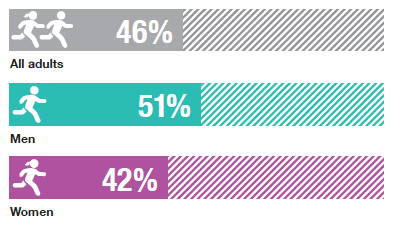
The proportion of adults that reported undertaking enough activity to meet the MVPA guidelines** declined with age.
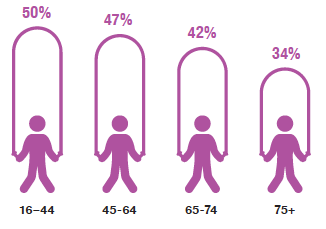
Adults who had been advised to shield reported lower physical activity levels.
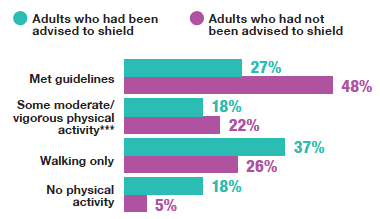
Men were more likely to report having spent a higher amount of time on sedentary† activities than women.
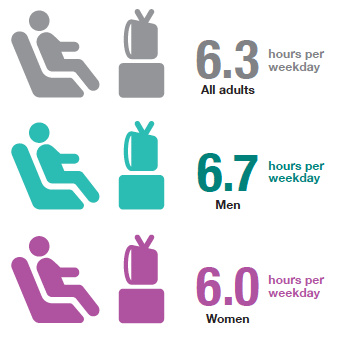
The average time spent on sedentary activities varied by age with the lowest levels among those aged 65-74.
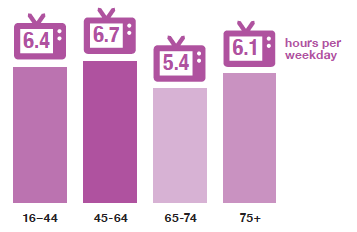
The amount of sedentary time reported was higher among adults who had been advised to shield than among those who had not.

* Information collected using the Short-Form International Physical Activity Questionnaire (IPAQ). This questionnaire defines activity levels based on reported moderate or vigorous physical activity (MVPA) but uses a less detailed set of questions than those included in the face-to-face SHeS surveys and hence it is not comparable with the face-to-face survey approach.
** at least 75 minutes per week of vigorous activity or 150 minutes per week of moderate activity (or some combination of the two).
*** not a significant difference. †Includes time spent at work, at home, while doing course work and during leisure time.
5 Physical Activity
Claire Elliott
5.1 Introduction
There is compelling evidence to support the health benefits of regular physical activity for all groups. In adults, there is strong evidence to demonstrate the protective effect on physical activity on a range of many chronic conditions including coronary heart disease, obesity and type 2 diabetes, mental health problems and social isolation. Regular physical activity can deliver cost savings for the health and care system and has wider social benefits for individuals and communities. These include increased productivity in the workplace and reduction in congestion and reduced air pollution through active travel[1].
The four UK Chief Medical Officers jointly issued revised physical activity guidelines in September 2019[1]. The guidelines recommend that, for good physical and mental health, adults should aim to be physically active every day. Any activity is better than none, and more is better still. Each week, adults should accumulate at least 150 minutes of moderate intensity activity; or 75 minutes of vigorous intensity activity; or even shorter durations of very vigorous intensity activity; or a combination of moderate, vigorous and very vigorous intensity activity. The guidelines also recommend that muscle strengthening activities are undertaken on at least two days a week but that any strengthening activity is better than none[2]. Sedentary time should be minimised as far as possible.
A Scotland where we eat well, have a healthy weight and are physically active is one of the six Public Health Priorities for Scotland published jointly by the Scottish Government and the Convention of Scottish Local Authorities (COSLA) in 2018[3]. The Active Scotland Delivery Plan, also published in 2018, supports this priority and identifies a wide range of actions across all sectors with the overall aim of reducing physical inactivity in adults and teenagers by 15% by 2030 and addressing existing inequalities in access to opportunities for and barriers to participation in physical activity[4].
Evidence is suggestive of varying impacts of the pandemic on diet and physical activity, with both positive and less beneficial actions adopted by individuals in response to their own and national circumstances, sometimes interchangeably[5]. Indoor and outdoor exercise facilities and clubs were closed at the end of March 2020 due to the coronavirus pandemic. Many workplaces were also closed with people encouraged to stay at home, reducing the potential for active travel and increasing opportunities to be sedentary. Throughout the lockdown period, people have been allowed to leave their homes in order to exercise with some restrictions on duration in place during the earlier stages of lockdown. During the data collection period, sport and exercise facilities largely remained closed with outdoor contact sports allowed to resume from 24th August and indoor exercise facilities able to reopen from the 31st of August[6].
This chapter presents findings on summary activity levels[7] and mean sedentary time among the Scottish adult population in August/September 2020. The questions used in the survey to collect this information were very different from those usually used in the Scottish Health Survey (SHeS)[8], so results are not comparable with other years. Information on methods and definitions can be found in Volume 2: Technical Report.
5.2 Physical Activity
The fieldwork period referenced in the following analysis covers from the 5th August 2020 to 23rd September 2020.
In interpreting these results, note that information on physical activity was collected using the Short-Form International Physical Activity Questionnaire (IPAQ). This questionnaire defines activity levels based on reported moderate or vigorous physical activity (MVPA) but uses a less detailed set of questions than those included in the face-to-face SHeS surveys and hence it is not comparable with the face-to-face survey approach.
A further consideration is that, as physical activity levels tend to be lower in deprived areas where response to this survey was lower than usual, the results in sections 5.2.1 and 5.2.2 may overestimate true prevalence. Conversely, sedentary time tends to be higher in deprived areas and hence the results in sections 5.2.3 and 5.2.4 may underestimate true prevalence.
See section 1.9.6 of the technical report for further details.
5.2.1 Adult summary activity levels, August/September 2020, by age and sex
During the fieldwork period, nearly half (46%) of all adults met the guidelines for moderate or vigorous physical activity (MVPA) of at least 75 minutes per week of vigorous activity or 150 minutes per week of moderate activity (or some combination of the two). Younger adults were more likely than older adults to meet the MVPA guidelines (50% of those aged 16-44 compared with 34% of those aged 75 and over).
A higher proportion of men met the MVPA guidelines than women (51% compared with 42% respectively) with the gap at its widest among those aged 75 and over (44% of men in this age group compared with 28% of women).
Just 6% of both men and women reported doing no physical activity at all in the previous week. The proportion reporting doing no physical activity in the previous week increased with age from 3% of those aged 16–44 to 13% among those aged 75 and over, with similar patterns for men and women. However, among those aged 75 and over, women were more likely than men to report undertaking no physical activity in the previous seven days (15% compared with 10% respectively).
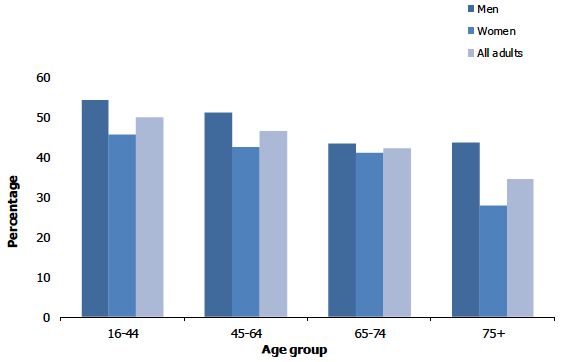
a Those who undertook more than 75 minutes per week of vigorous activity or 150 minutes per week of moderate activity (or some combination of the two).
Figure 5A, Table 5.1
5.2.2 Adult summary activity levels, August/September 2020, by whether received shielding letter/text and sex
Those who had been advised to shield (either by letter or text) were less likely to meet the MVPA guidelines than those who had not been advised to shield (27% compared with 48%).
This difference between the proportion of those advised to shield meeting the MVPA guidelines and those not advised to shield was more pronounced for men than for women (25% of men that received a shielding letter/text met the guidelines compared with 53% who had not; the equivalent figures for women were 28% and 44%).
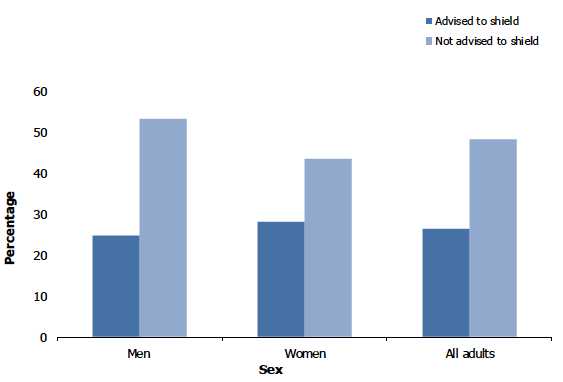
a Those who undertook more than 75 minutes per week of vigorous activity or 150 minutes per week of moderate activity (or some combination of the two).
Figure 5B, Table 5.2
5.2.3 Adult sedentary time[9] on an average weekday, August/September 2020, by age and sex
During the fieldwork period, all adults recorded an average of 6.3 hours of sedentary time per weekday. The average time spent on sedentary activities varied by age with the lowest levels among those aged 65-74 (5.4 hours compared with 6.1 hours – 6.7 hours among other age groups).
While the average sedentary time per weekday was significantly lower for women than for men (6.0 hours on average compared with 6.7 hours), the pattern by age was similar for both sexes.
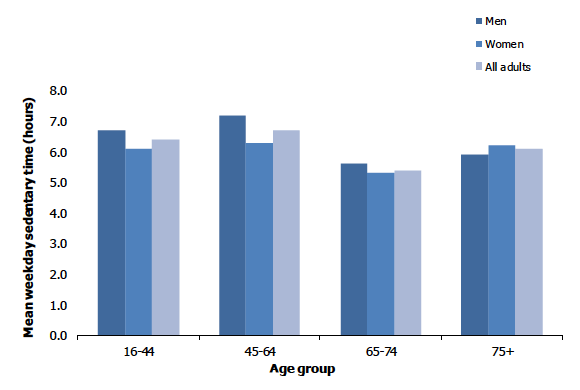
Figure 5C, Table 5.3
5.2.4 Adult sedentary time on an average weekday, August/September 2020, by whether received shielding letter/text and sex
Adults who had been advised to shield (either by letter or text) reported more sedentary time on weekdays than those who had not received such advice (averages of 7.3 hours and 6.3 hours respectively). Similar patterns by shielding status were reported by men and women.
Table 5.4
Table List
Table 5.1 Adult summary activity levels, August/September 2020, by age and sex
Table 5.2 Adult summary activity levels, August/September 2020, by whether received shielding letter/text and sex
Table 5.3 Adult sedentary time on an average weekday, August/September 2020, by age and sex
Table 5.4 Adult sedentary time on an average weekday, August/September 2020, by whether received shielding letter/text and sex
The tables can be found in the main report page under supporting documents.
References and notes
1. UK Chief Medical Officer’ Physical Activity Guidelines (2019). Department of Health & Social Care, Welsh Government, Scottish Government & Northern Ireland Department of Health. [online].
2. It should be noted that the SHeS telephone survey did not ask question on or distinguish between activities that could be categorised as muscle strengthening.
3. Public Health Priorities for Scotland (2018). COSLA & Scottish [online].
4. See: gov.scot: Active Scotland Delivery Plan
5. Ingram, J, Maciejewski, G and Hand, C. (2020). Changes in Diet, Sleep, and Physical Activity Are Associated With Differences in Negative Mood During COVID-19 Lockdown. Frontiers in Psychology.
6. Coronavirus (COVID-19): Scotland’s route map. Edinburgh: Scottish Government (2020).
7. While the guidelines differ for those aged 16 to 18 years old, for the purposes of SHeS, the activity of these participants is included in the all adult calculations.
8. Information on physical activity was collected using the Short-Form International Physical Activity Questionnaire (IPAQ). See the technical report for further details.
9. Includes time spent at work, at home, while doing course work and during leisure time.
Contact
There is a problem
Thanks for your feedback